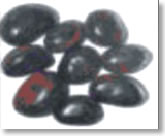
ATMAGUPTA/ KAPIKACCHU
Botanical Name: Mucuna prurita (FABACEAE)
English Name: Cow-hage or Cow-itch
Hindi Name: Kaunch, aalukusi

Introduction: This plant is one of the very important herbs in the ancient medical literature both for its effects as well as side-effects. The therapeutic benefits of this plant are seen in parkin son’s disease, infertility, CNS disorders etc. The side-effects are primarily associated with the pod hair which is known to cause skin irritation and allergy to many resulting in itching. Hence the name Kapikacchu. All the ayurvedic texts have mentioned about the medicinal values of this plant and is extensively used in therapeutics for male infertility and impotency.
Distribution: It is a herbaceous twinning annual, which is found commonly all over India.
Chemical Constituents: L-dopa, mucunine, mucunadine, prurienine, purienine, tryptamine etc.
Parts Used: Seeds & root ( In homoeopathy pod hair powder is used as anthelminitic).
Properties: Sweet, tonic, anti-convulsive, alterative, nutritious etc.
Indications: Parkinsonism, impotency, male infertility, dysuria, CNS disorders etc.
Dose: Seed powder 3-6g; root decoction 50-100ml; pod hair powder 125mg.
Therapeutic Uses:
- Worm infestation: Pod hair powder is given with jaggary, honey or butter.
- Atisara: Root paste is administered orally in dysentery.
Scientific Studies
CNS activity: Total alkaloids of seeds showed weak neuron-muscular blocking effects of frog rectus abdominus ( Bhattacharya & Sanyal, 1969). Bufotenine showed both in vitro and in vivo anticholonesterase activity ( Bhattacharya & Sanyal, 1971).
Anti- parkinonian activity: The seed extract (200 mg/kg i.p) showed potent effect which was not due to L-dopa alone ( Nath et al;l 1981).
Anti-hypertensive activity: Seed extract showed hypotensive activity in dogs ( Ramaswamy et al.,1979).
Antispasmodic activity: Indolic bases derived from seeds showed anti-spasmodic acion on smooth muscle preparations ( Ghosal et al., 1970, 1971 & Ramaswamy et al., 1979).
Anti-diabetic activity: Seed diet produced hypoglycemic effet in normal rats (Pant et al., 1968).
Hypolipidemic activity: Seed diet showed hypocholesterolemic effect in rats ( Rant et al.., 1968). The protein isolated from seeds in diet led to a reduction in the cholesterol content of liver and blood in rats (Singh et al., 1968).
Cultivation Technology: The plant can be grown on wide range of soils from slightly acidic to alkaline soils. It is easily propagated through seed. Seeds can be sown in March-April in irrigated and June-July under unirrigated conditions. Seeds are sown in pits, which are made at a distance of 2x2m. 4-5seeds per pit are sufficient. Slight irrigation after sowing is required and after its establishment, it grows very gregariously. Therefore, it is suitable for those fields where there is a severe weed problem as it suppress weed growth.
Harvesting : Mature pods are collected and control burning is done to remove hairs of pods.







